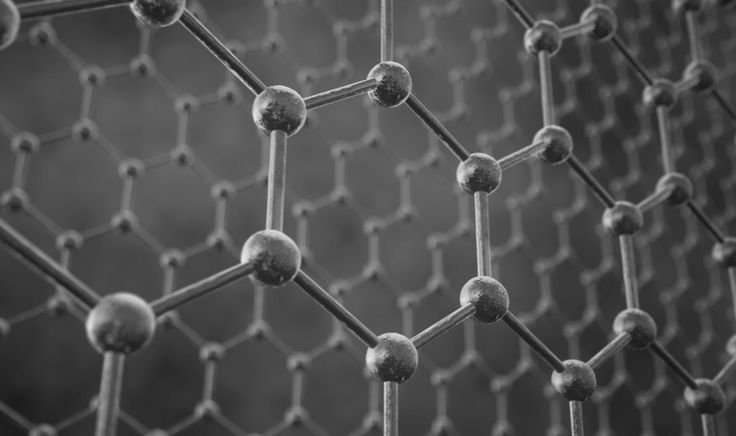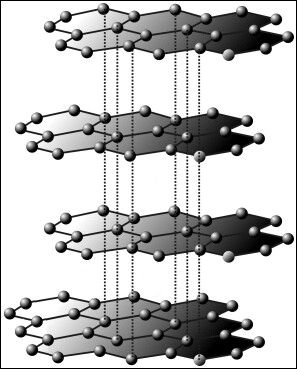
The discovery of graphene led everyone to believe that it was the most essential breakthrough in material since the invention of plastic. It is around a million times thinner than hair, and still around 200 times stronger than steel. This opened up numerous possibilities for its use and the future of human technology as a whole. There were talks about graphene being able to replace silicon in electronics and transistors. There were also discussions that it could be utilized to build an actual elevator from earth to space. This alone had the potential to change the destiny of humankind as it would make us a trans-planetary civilization.
However, we haven’t witnessed any evidence of these remarkable things that graphene could allegedly build. There are a lot of other quirks that can explain as to why the material hasn’t lived up to its potential yet. But before diving into that, we have to study graphene itself.
𝗗𝗜𝗦𝗖𝗢𝗩𝗘𝗥𝗬
Graphene was discovered by Kostya Novoselov and Andre Geim at the University of Manchester, UK in 2004. The discovery process was very simple. They stuck sticky tape on a piece of graphite,( a carbon-based material used by generations of students and teachers in the form of pencils) and then peeled it off. They did this several times until the tape was left with a single layer of graphene. In 2010, they won a Nobel Prize for it.
𝗦𝗧𝗥𝗨𝗖𝗧𝗨𝗥𝗘
Graphene is a man-made material which has extraordinary properties. It is a single layer of graphite. However, graphene has a two-dimensional structure, whereas graphite has a three-dimensional crystalline one. This allows graphene to be very slim, which means that it is one atom thick as it doesn’t have a third dimension.
The atoms in graphene are laid side by side in a hexagonal manner. Hence, atomically, it resembles a chicken wire. Its structure is its most important aspect as this is what allows each carbon atom to be covalently bonded to three more around it. This makes graphene extremely stable and strong. It is a very good conductor of heat and electricity as well. The reason behind it being a good conductor of electricity is that its atoms delocalize electrons, i.e., they can run around freely.
𝗖𝗛𝗔𝗟𝗟𝗘𝗡𝗚𝗘𝗦
There isn’t enough graphene production. Even when graphene was first isolated, it was done in extremely minute amounts, which has been the problem for years now. A reliable way to scale up the production hasn’t yet been found. Though a way to mass produce graphene already exists, the quality of the end product is a long way from the quality needed for graphene to become the wonder material.
However, one material that graphene could replace is silicone. But silicone has remarkable semiconducting capacity and is hence an excellent material for electronics. It hardly has any weaknesses and hence, graphene has to be better to be able to replace it.
It is extremely difficult to produce a large sheet of two-dimensional materials using modern production methods. At present, whenever scientists try to create a large sheet of graphene, it breaks into tiny flakes or turns into something that is not graphene. Since graphene is just graphite layered upon itself, attempts to create graphene often just result in graphite.
But this isn’t to say that there haven’t been any successful attempts to create graphene. For example, researchers at Rutgers University has found easiest way to make large quantities of graphene is to exfoliate graphite into individual graphene sheets by using chemicals. The downside of this approach is that side reactions occur with oxygen – forming graphene oxide that is electrically non-conducting, which makes it less useful for products.
Removing oxygen from graphene oxide to obtain high-quality graphene has been a major challenge over the past two decades for the scientific community working on graphene. Oxygen distorts the pristine atomic structure of graphene and degrades its properties.
 Mariah Chhowalla, a professor in Department of Material Science in Rutgers University and his group members found that baking the exfoliated graphene oxide for just one second in a 1,000-watt microwave oven, like those used in households across America, can eliminate virtually all of the oxygen from graphene oxide. This leads to exceptionally high quality graphene with properties approaching those in pristine graphene.
Mariah Chhowalla, a professor in Department of Material Science in Rutgers University and his group members found that baking the exfoliated graphene oxide for just one second in a 1,000-watt microwave oven, like those used in households across America, can eliminate virtually all of the oxygen from graphene oxide. This leads to exceptionally high quality graphene with properties approaching those in pristine graphene.
𝐀𝐏𝐏𝐋𝐈𝐂𝐀𝐓𝐈𝐎𝐍𝐒
𝗚𝗥𝗔𝗣𝗛𝗘𝗡𝗘 𝗜𝗡 𝗔𝗘𝗥𝗢𝗡𝗔𝗨𝗧𝗜𝗖𝗔𝗟 𝗙𝗜𝗘𝗟𝗗
Graphene is already being utilized to create lighter, impact-resistant helicopter and aircraft structures. It will also be possible to create de-icing systems integrated into the wings, thanks to the high electrical conductivity of graphene. Its shielding capacity can then help to produce paints that decrease radar footprint. This will make the aircraft invisible and also help build wind farms that don’t disturb the radar activity that studies air traffic.
𝗚𝗥𝗔𝗣𝗛𝗘𝗡𝗘 𝗜𝗡 𝗙𝗨𝗘𝗟 𝗦𝗬𝗦𝗧𝗘𝗠𝗦 𝗢𝗙 𝗔𝗜𝗥𝗖𝗥𝗔𝗙𝗧𝗦
Graphene oxide membranes are selective to water when compared to other liquids i.e., from oils, and have hence been used to remove water from fuel tanks.
𝗚𝗥𝗔𝗣𝗛𝗘𝗡𝗘 𝗖𝗔𝗕𝗟𝗘 𝗙𝗢𝗥 𝗦𝗣𝗔𝗖𝗘 𝗟𝗜𝗙𝗧𝗦
Single-crystal graphene on the other hand, has a tensile strength of 130GPa. (130000 MPa). It is the strongest material ever tested and will be strong enough to make a space elevator tether.
𝗚𝗥𝗔𝗣𝗛𝗘𝗡𝗘-𝗕𝗔𝗦𝗘𝗗 𝗦𝗠𝗔𝗥𝗧 𝗖𝗢𝗔𝗧𝗜𝗡𝗚 𝗙𝗢𝗥 𝗦𝗔𝗧𝗘𝗟𝗟𝗜𝗧𝗘𝗦, 𝗧𝗢 𝗖𝗢𝗡𝗧𝗥𝗢𝗟 𝗧𝗛𝗘𝗥𝗠𝗔𝗟 𝗥𝗔𝗗𝗜𝗔𝗧𝗜𝗢𝗡
Space is full of astonishing extremes, and temperature in space is no different between Sun-facing and Earth-facing aspects, a satellite can experience temperature variations of more than 400°C. Due to this the thermal management options becomes extremely difficult; they are large, heavy and entail high power consumption, which can quickly diminish a satellite’s power reserves.
The team (Manchester University) has developed a graphene-based smart coating for satellites, allowing them to manage thermal energy in real-time, depending on whether a satellite’s surface is Earth’s shadow or on the side closest to the Sun.
This graphene technology is a far more optimal solution as it is lightweight, has a low power consumption, can respond quickly to temperature changes, operates across the infrared spectrum, and involves no moving parts.
𝗣𝗢𝗧𝗘𝗡𝗧𝗜𝗔𝗟 𝗢𝗙 𝗚𝗥𝗔𝗣𝗛𝗘𝗡𝗘
Power storage : Graphene has the potential to revolutionize battery storage capacities and also charge batteries faster. Samsung recently revealed it is working on a graphene-based battery. The patent details state that it can store 45% more power and can completely charge in only 12 minutes.
Data storage : The simple but effective structure of graphene makes it excellent for data storage units. They are expected to have faster flash memories than conventional data storage units.
Tools : Being lightweight yet super strong, graphene can be used to make machines lighter, compact, and as efficient as ever.
Sports : Several sports equipment can be vastly improved by replacing the carbon-fibre base with graphene, which is lighter but way stronger.
Touchscreen : Graphene has impressive optic properties which make it practically transparent and very strong, in addition to having remarkable electric conductivity.
Biosensors : Graphene can measure a patient’s cholesterol levels, blood sugar range, and even their DNA efficiently. It is also known to be extremely useful in making medical equipment used to administer intravenous medications.
Supercapacitors : Graphene-based capacitors have the potential to replace conventional batteries.
Waterproofing : Graphene is super thin yet durable and can be used in water-proof coatings for industrial machinery as well as ocean liners and aircraft.
Water purification : The delicate structure and uniform nature of the connection between its carbon atoms makes graphene an excellent component for water filters.
– The writer is an Aerospace and Defence Analyst & Director ADD Engineering Components (India) Pvt Ltd (An Indo- German Company).








